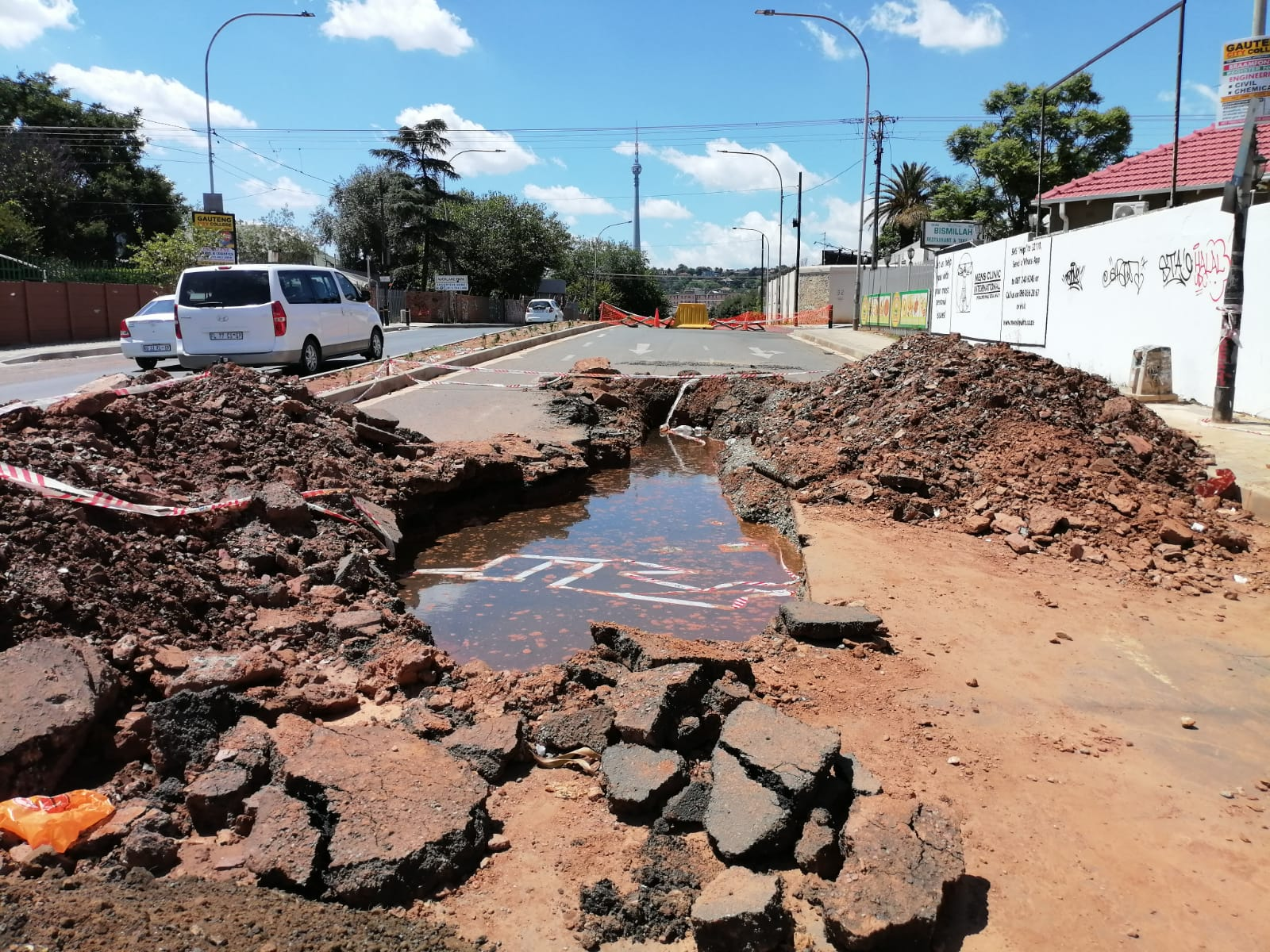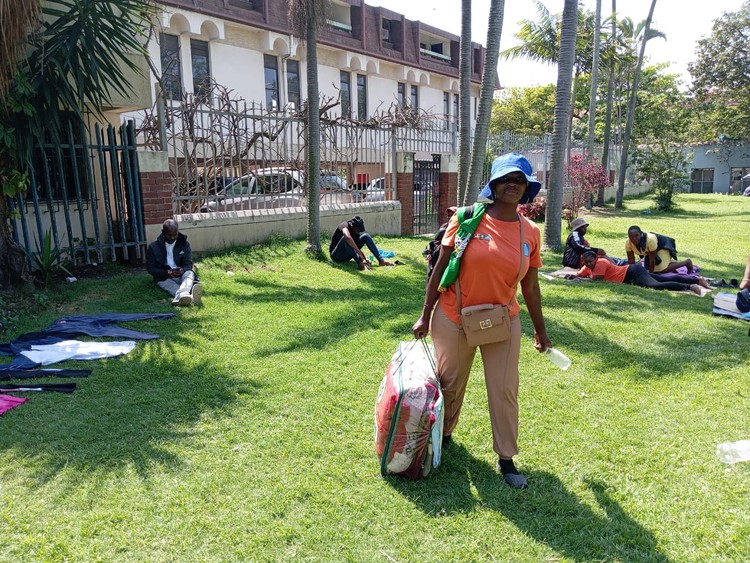By Jane Viedge
A few weeks ago, the St Aidan’s Avenue WhatsApp group began vibrating with new energy. Possibly influenced by ‘GoBokke gees’, we were fully engaged in the kind of team spirit that spurs action and gets results. The catalyst: new resident, Leard King. The project: raising funds to fix our pothole-bedevilled road that was dissolving before our eyes and slowly killing our cars and our will to live.
Behind the scenes, Leard organised the logistics with Makana Revive! which, alongside Makana Municipality, executes private road-fixing projects enabled by the National Arts Festival’s Social Employment Fund. Under Leard’s guidance, we decided that fixing a strip of road was a longer-term solution than filling in potholes, even though it would cost more. But it meant we were limited to fixing about a third of the worst bits.
Despite knowing that their portion of the road may not be fixed, most residents responded generously. Megan Heroldt, head teacher at Wizkidz, donated money and printed and distributed fliers outlining the benefits and bank details.
Tenant Anna Bloom, a Swiss academic on a short-term stay, donated to the fund even though she is a pedestrian and never uses the pothole-ridden part of the road. As her landlord, I happen to know her R500 contribution means she will miss out on a few cups of coffee this month. Anna donated because she was impressed by the joint effort and enthusiasm of the residents. She commented, “Trusting that all community voices are valid is the foundation of direct democracy as I understand it…I think that’s an interesting dynamic worth exploring in the larger context of this municipality’s current challenges to deliver public service.”
At the time of publishing this story, the St Aidan’s collective had contributed R43 000 to the Makana Revive! Account. The tar cost approximately R28 000, and the labour, R7000. The remaining R8000 will literally be kept for rainy days (when potholes appear again).
On the day the tar arrived, I walked down to the Milner Street side of St Aidan’s to document the much-anticipated event. I was aware of the narrative on social media where people question why ‘so many workers stand around while a few actually fix the potholes’. The workers, as most of us in our city now know, are a large group of unemployed Makhandan citizens being trained in a range of skills, from fixing potholes to creating food gardens. I chatted to some, and their message was clear: this SEF project has been a lifeline, long may it continue.
Watch here as Nkosinathi Ziela explains how the project has changed his life.
St Aidan’s resident Leard King and bitumen repair specialist Alfred Gwe pose in St Aidan’s Avenue at the road repair site. Photo: supplied
Watching with interest was Leard, whose company, King Constructions, is highly experienced in road maintenance. As residents, we all have an amount of self-interest in seeing the road fixed. But I was curious about how Leard managed to galvanise things. “I am a farm boy at heart. When everyone chips in, the job gets done.” Leard wasn’t seeking recognition; he saw a need and stepped up.
Retired Rhodes University professor and resident Paul Walters found security in this community-led action. “What Leard proposed seemed modest and doable,” he said. “I would be prepared to make small regular contributions, having seen the potential power of broad-based small but regular contributions.”
In October, SEF workers laid down 147 tonnes of asphalt in Makhanda, according to local businesswoman Dagmar Kirk, who has been training the workers and overseeing the road-fixing activities alongside Alfred Gwe, a bitumen repair specialist. The St Aidan’s contribution of 14.5 tonnes was the only private input, with the balance from the municipality. Much to the residents’ delight, the municipality matched our 14 tonnes with a further 14 to take the tar further up the road.
Beyond St Aidan’s Avenue, the municipality had also funded asphalt works around the angel statue in High Street, Graeme College – supplemented by 24 tonnes from Makana Brick–Milner, Scott, Huntley streets and Coles Lane, among others. Dagmar tells me she liaises with the municipality’s CFO daily to plan road-fixing efforts. November will see much-needed work done in the Kingswood area.
In the interim, Makhandan residents and businesses need to replicate the St Aidan’s approach where possible. In St Aidan’s, there are several locally owned businesses that have put a lot of money into fixing roads all over town. Beer Properties is one; the Oyster Collection is another. Owner of 8A St Aidan’s, an Oyster Collection luxury lodge, Nicolas Poole, commented, “This project isn’t just a quick fix. It’s a template of what can be achieved when communities take the reins.”
Wizkidz’ Megan agrees in principle but is also apprehensive. “I’m concerned about how our road will fare, especially during heavy rains,” she said, echoing a concern many of us share about the long-term viability of our efforts.
The reality is we’re just one country with pothole problems. Communities in Canada, the USA and Britain are all facing similar situations where local government budgets cannot measure up to the fixes required. As long as there’s water, there are potholes. The recent heavy rains in Makhanda played havoc with our roads, and in St Aidan’s, Leard is keen to contribute his own resources to improve the water drainage. He is also offering to work with Dagmar and NAF to train a select number of SEF workers in laying brick pavers as an alternative to tar.
This kind of collaboration is our future, and we must embrace it – is the message I get from Business Forum CEO Richard Gaybba. He says, “I firmly believe it is unrealistic to rely solely on the government, whether at the local or national level, to magically resolve all issues. Having a resource like Makana Revive! offers us a practical avenue to address and maintain our local infrastructure. Importantly, this does not excuse the government from fulfilling its legal responsibilities. Instead, it emphasises the significance of shared responsibility and proactive community involvement in shaping a more resilient local environment.”
Come May 2024, the SEF money will dry up. What happens after is crucial.
For her part, Dagmar is focused on creating sustainable solutions to our road problems, and she and NAF have a few plans up their sleeves that will take the city’s infrastructure fixes to an exciting new level. We’ll watch the space.
SEF workers prepare St Aidan’s Avenue for hot tar. The workers are skilled in all phases of the repair work. Photo: supplied






